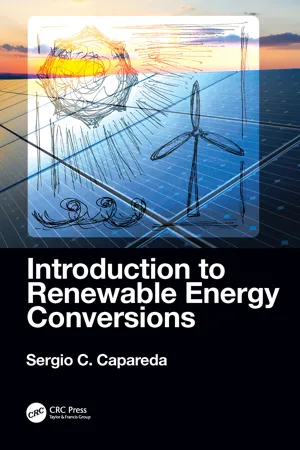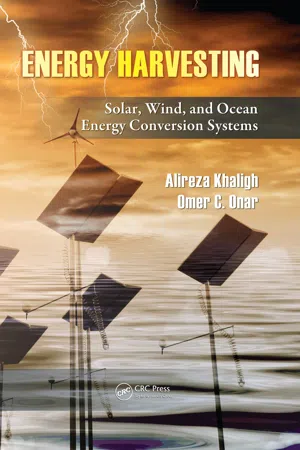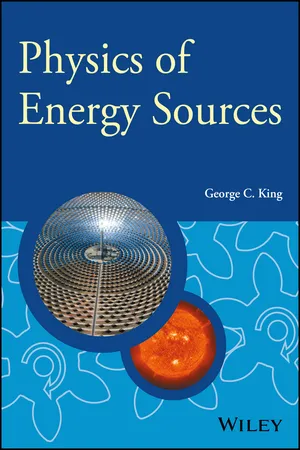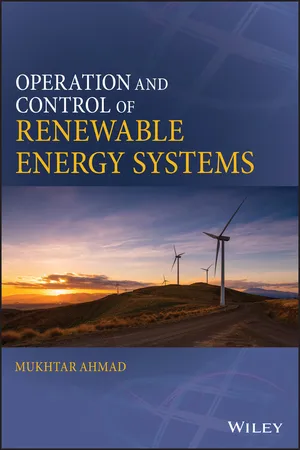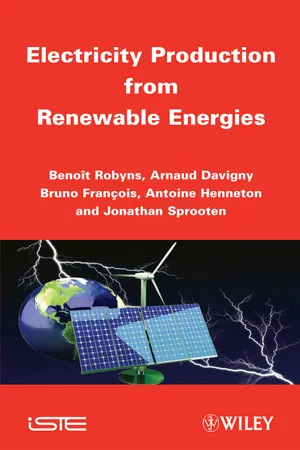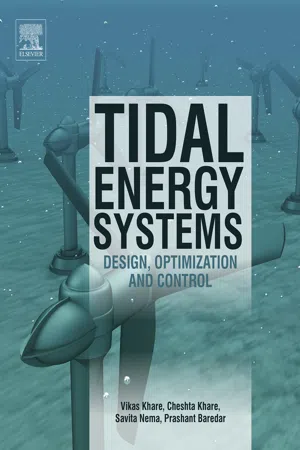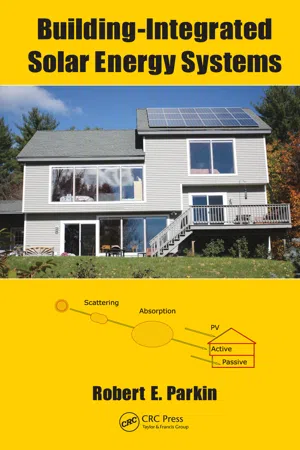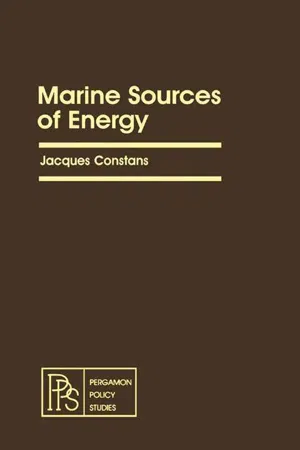Geography
Tidal Power
Tidal power is a form of renewable energy that harnesses the energy of tides to generate electricity. It involves capturing the kinetic energy of moving water caused by the gravitational pull of the moon and the sun. Tidal power can be harnessed through various technologies such as tidal stream systems, tidal barrages, and tidal lagoons.
Written by Perlego with AI-assistance
Related key terms
11 Key excerpts on "Tidal Power"
- eBook - ePub
- Sergio Capareda(Author)
- 2019(Publication Date)
- CRC Press(Publisher)
9Tidal Energy
Learning Objectives
Upon completion of this chapter, one should be able to:- Describe the principles of harnessing tidal energy to generate useful power.
- Classify the various schemes of power generation from tidal energy.
- Describe the potential tidal energy available in the United States and worldwide.
- Compare the estimated cost of electrical energy produced from tidal energy from various countries.
- Relate the environmental and economic issues concerning tidal energy conversion.
9.1 Introduction
Tidal energy results from the forces of gravitational attraction between the earth, the sun, and the moon. The moon contributes to these gravitational forces and either creates additional tidal energy or subtracts from the sun's forces depending on its physical orientation. Because of gravity, the parts of the earth closest to the moon have higher tides, while those in the middle parts have the lowest. These “humps” occur twice every 24 hours and 50 minutes, which is also the time of the moon's apparent rotation around the earth. Tides due to the attraction of the moon, called semi-diurnal tides, occur every 12 hours and 25 minutes. Figure 9.1 shows the primary areas in the world with high potential for tidal energy. Figure 9.2 shows the variation of the height of the wave deviation as a function of time based on mean sea level. The way to take advantage of these tidal energies is to find a place on the shores of islands or continents where the tide elevations are at maximum. The energy derived comes from the potential and kinetic energy of water bodies similar to those used in hydro power plants.The sun has an understandably strong effect on the variations of these tides. During a full moon or new moon, the sun's attractive forces add to the pull of the tidal “humps,” and this makes the tidal heights higher than normal (see illustrations in Figure 9.1 - eBook - ePub
Energy Harvesting
Solar, Wind, and Ocean Energy Conversion Systems
- Alireza Khaligh, Omer C. Onar(Authors)
- 2017(Publication Date)
- CRC Press(Publisher)
3 Tidal Energy Harvesting3.1 Introduction
The generation of electrical power from ocean tides is very similar to traditional hydro-electric power generation. The simplest generation system for tidal plants involves a dam, known as a barrage, across an inlet. Usually, a Tidal Power plant consists of a tidal pond created by a dam, a powerhouse containing a turbo-generator, and a sluice gate to allow the bidirectional tidal flow. The rising tidal waters fill the tidal basin after opening the gate of the dam, during the flood tide. The gates are closed, when the dam is filled to capacity. After the ocean water has receded, the tidal basin is released through a turbo-generator. Power can be generated during ebb tide, flood tide, or both. Ebb tide occurs when the water is pulled back, and flood tide occurs when the water level increases near the shore [1 ]. Studies demonstrate that the Tidal Power will be economical at sites where mean tidal range exceeds 16 ft [1 ,2 ].One of the advantages of tidal energy harvesting is that the tidal current is regular and predictable. Furthermore, tidal current is not affected by climate change, lack of rain, or snowmelt. Environmental and physical impacts and pollution issues are negligible. In addition, Tidal Power can be used for water electrolysis in hydrogen production and desalination applications [3 ]. However, Tidal Power generation is a very new technology, which needs further investigations and developments.Similar to the wind turbines, tidal turbines can be used for tidal energy harvesting. Tidal turbines and wind turbines are similar in both appearance and structure, to some extent. Tidal turbines can be located in river estuaries and wherever there is a strong tidal flow. Since water is about 800 times as dense as air, tidal turbines have to be much stronger than wind turbines. They will be heavier and more expensive; however, they will be able to capture more energy at much higher densities [4 ]. A typical tidal turbine is shown in Figure 3.1 - eBook - ePub
Power Engineering
Advances and Challenges Part B: Electrical Power
- Viorel Badescu, George Cristian Lazaroiu, Linda Barelli(Authors)
- 2018(Publication Date)
- CRC Press(Publisher)
Tides are the result of gravitational attraction of Earth, Sun and Moon that acts on the Earth’s oceans. This causes the slow motion of large masses of water. Tidal energy consists of both potential energy, related to vertical variations of the sea level, and kinetic energy, related to the horizontal motion of the water column.At first glance, power generation with wave and tidal energy has important advantages over other common renewable energy sources. First of all, they could allow powering coastal regions where 44% of the global population lives and where land availability for other renewable sources (wind, solar) is often scarce (United Nations 2016). Secondly, they are available throughout the day (unlike solar energy). Thirdly, they are highly predictable (2–3 days in advance for waves and weeks or months for tides, unlike wind energy). These points facilitate the delivery of electrical power to the grid, the integration with other sources of energy and the reduction of power cuts. In addition, the production of electricity from ocean energy is CO2 free, unlike biomass and geothermal energy, and has limited visual impact on the shoreline. These factors make ocean energy very attractive, especially considering the worldwide energy potential.2. The Energy PotentialFor both wave and tidal resources, the energy potential is huge. Recently, the global wave power (theoretical) potential has been estimated as high as 2,100 GW (Gunn and Stock-Williams 2012), at 30 nautical miles from the coastline. The countries with the highest potential are Australia, the United States of America and Chile (see Table 1 and Fig. 1 - eBook - ePub
- George C. King(Author)
- 2017(Publication Date)
- Wiley(Publisher)
currents may reach speeds of ∼5 m/s and provide an alternative way to harvest Tidal Power. This power can be harnessed in a similar manner to the way wind turbines harness wind power although, of course, the water turbines are located under water.We remark straight away that tidal motions are complicated and so are difficult to predict. This is not least because of the topography of a particular location, for example the shape of the seabed close to a coastline or the occurrence of estuaries or bays. However, detailed observations have been made of tidal motion over many decades at many locations because knowledge of local tides is essential for the navigation of shipping. And it is these long-term observations that are the basis upon which tide motion can now be successfully predicted. Thus any variations in output power from a Tidal Power plant can be foreseen and taken into account when delivering power to a national grid. Tidal Power has other important advantages. It is a renewable energy source and it has the potential to deliver enormous amounts of energy. It is estimated that the sites of greatest potential throughout the world could provide ∼120 GW of power and that, in principle, 25% of the UK's energy needs could be supplied by Tidal Power. The main drawback of Tidal Power has to do with the very high costs involved in building the power plants. Moreover, the sites for these plants have very specific requirements with regard to their topography, and the availability of suitable sites is limited. An additional issue is the large ecological impact that a Tidal Power plant has on the local environment. For these reasons, only a few Tidal Power plants have been constructed so far. However, further plants are being proposed including one to be sited in the Bristol Channel, UK. In this section we present simplified models to describe the origin and behaviour of the tides. We also describe ways in which Tidal Power can be harnessed. - Mukhtar Ahmad(Author)
- 2017(Publication Date)
- Wiley(Publisher)
Chapter 10 Ocean Energy10.1 Energy from Ocean
Oceans, covering over 70% of the Earth's surface, are the world's largest collector and retainer of the Sun's vast energy. This vast energy from the oceans is available in the form of tides, ocean thermal (due to temperature difference), ocean currents and waves [1–3]. Tidal energy is the oldest form of renewable energy, which was used in the water mills by the Romans when they occupied England. Tidal mills were also built in Spain, France, United Kingdom and China during medieval period, around AD 1100. However, it was not until the 20th century that it was investigated as a potential source of electricity. The first ever Tidal Power plant was opened in 1966 in La Rance, France. It has reliably generated power for more than 15 h/day and has delivered 500–600 GWh annually since 1967. However, this type of plant was not erected in other areas owing to the high cost of power plant components and difficulty in locating sites in which such power plants could be built. Now in order to find new renewable energy sources, there is renewed interest in these technologies. Significant growth has occurred in the number of devices developed for ocean energy conversion since 2003. Many countries are now involved in finding new technology and in research and development for application of ocean energy.Tidal energy is clean renewable green energy and is non-polluting, reliable and predictable. In 1687, Sir Isaac Newton explained that ocean tides result from the gravitational attraction of the Sun and the Moon on the oceans of the Earth. Newton's law of universal gravitation states that the gravitational attraction between two bodies is directly proportional to the product of their masses and inversely proportional to the square of the distance between the bodies. The tidal generating forces vary inversely as the cube of the distance of the tide generating object. Thus, Moon plays a more significant role in the creation of tides compared to the Sun because of its proximity to the Earth although the mass of the Sun is much larger. The gravitational attraction between the Earth and the Moon is the strongest on the side of the Earth that is facing the Moon, because it is closer. This attraction causes the water on this “near side” of the Earth to be pulled towards the Moon. On the other hand, the Earth is also being pulled towards the Moon (and away from the water on the far side). As the Earth rotates, these two bulges travel at the same rate as the Earth's rotation. The Moon rotates around the Earth with respect to the Sun approximately 29.5 days (lunar month) in the same direction that the Earth rotates every 24 h. Ocean levels fluctuate daily as the Sun, Moon and Earth interact. As the Moon travels around the Earth and as they, together, travel around the Sun, the combined gravitational forces cause the world's oceans to rise and fall. Since the Earth is rotating at the same time when this phenomenon takes place, there are two high tides and two low tides each day. However, these periods do not happen at the same time each day. This is because the Moon takes slightly longer than 24 h to line up again exactly with the same point on the Earth – about 50 min more. Therefore, the timing of high tides is staggered throughout the course of a month, with each tide commencing approximately 24 h and 50 min later than the one before it. The ocean is constantly moving from high tide to low tide and then back to high tide. When the sSun and Moon are aligned, there are exceptionally strong gravitational forces, causing very high and very low tides which are called spring tides, occurring at full and new moon, respectively, as shown in Fig. 10.1 (a) and (b). The spring in spring tide is not related with the season. Spring tides are very strong because the Moon and the Sun both are responsible for it. When the Sun and Moon are not aligned and are perpendicular to one another (with respect to the Earth), the gravitational forces cancel each other out, and the tides are of minimum range. These are called neap tides- eBook - ePub
Ten Technologies to Save the Planet
Energy Options for a Low-Carbon Future
- Chris Goodall(Author)
- 2010(Publication Date)
- Greystone Books(Publisher)
This dismissive attitude to the usefulness of tidal energy was widely shared until recently. The total amount of energy in the tides across the world is not enormous, at least when compared with solar or wind power, or indeed the energy in waves. However, it is still far more than the total power needed by today’s electricity grids. The energy contained in the global tides at any one moment is probably about 3,800 gigawatts, or almost twice today’s worldwide electricity consumption. Most tidal energy is impossible to extract; it is found in deep oceans far from coastlines. But at a small number of places, such as the Pentland Firth or the Bay of Fundy, huge resources of energy are concentrated into narrow funnels.Of course, tidal-stream turbines are not the only way to capture energy from the seas. Barrages are another option. These large dams harness their energy from the “range” of the tide, or the difference between its high and its low points. The barrage is built across a tidal river or estuary, and the incoming tide is allowed in through sluices. When the tide reverses, the sluices are opened, and the force of outgoing tide turns electricity turbines. We know that tidal barrages will work, as there are already commercial plants in France, Canada, and Russia.There are also at least three marine-energy technologies that don’t rely on either the range or the current of the tides. First, turbines could be positioned to collect the energy of the main ocean currents, such as the Gulf Stream. Second, wave power collectors can use the up-and-down motion of the sea as the waves pass. Finally, heat pumps can use differences between the temperature of the sea surface and the deep ocean to drive an engine, usually to generate electricity.All of these technologies are commercially interesting, but, as this chapter shows, the power from tidal currents and ocean waves looks like the easiest to exploit and offers us the biggest potential for generating electricity.THE POTENTIAL FOR ENERGY FROM THE SEASAlthough both the vigor and the regularity of marine energy have been obvious since humans started to sail the oceans, we have been slow to exploit their potential. Even now, only a dozen or so sites around the globe successfully generate electricity from the oceans. France built a large barrage across the River Rance to collect energy from the tides on the northern coast of Brittany over forty years ago, and a small number of other places with large ranges between the high and low tides have installed similar dams. A prototype power station in Hawaii has occasionally generated electricity from ocean temperature variations. But the general picture is of hesitant and slow progress. Only in the last few years has the pace of installation started to pick up. The first two commercial-scale turbines that capture the flow of the tide on the ocean floor have been connected to the U.K. electricity grid, and a small wave power farm has been installed off the coast of Portugal. Vancouver-based Clean Current’s prototype tidal stream turbine has been successfully tested at Race Rocks off the coast of British Columbia, and a few other developers have put working machines in the water. - eBook - ePub
Renewable Energy Sources
Watt Committee: report number 22
- M.A. Laughton(Author)
- 1990(Publication Date)
- CRC Press(Publisher)
Part 2 TYPES OF RENEWABLE ENERGY SOURCEPassage contains an image
Section 3 Tidal Energy
3.1 TECHNOLOGY
There are two types of technology involved in extracting energy from the tides. The first is based on the capture of tidal energy as potential energy within a basin. The second is based on the direct extraction of the kinetic energy of tidal streams. The latter is a relatively diffuse source and, although the subject of numerous technical papers, has been developed only at very small scale, for example for lighting navigation buoys. Therefore this section discusses the concept of Tidal Power extracted by turbines installed in barrages which enclose inlets or estuaries and thus develop a substantial differential head.In its most basic form, the technology of Tidal Power is simple: the rising ‘flood’ tide enters the basin through gated openings or ‘sluices’ and through the turbines idling in reverse (Fig. 3.1 ). At high tide, all openings are closed until the tide has ebbed enough to develop a useful head across the barrage. The turbines are then opened and generate electricity for several hours, until the difference in level between the emptying basin and the next flood tide has dropped to the minimum at which the turbines can operate. Shortly after, the tide level and basin level will be equal, the sluices are opened and the cycle repeats.There are several alternative methods of operation available. These include:- modifying the design of an ebb generation scheme so that, at around high water, the turbines are used as pumps to raise the level of water in the basin. By pumping at low head and then using the same water at higher head, a net gain in energy may be achieved;
- generating during both the flood and ebb tides. The 240 MW barrage at La Rance in France was designed both to operate in this manner and to pump in each direction. It is now operated mainly as an ebb generation scheme with pumping at high tide;
- eBook - ePub
- Benoit Robyns, Arnaud Davigny, Bruno François, Antoine Henneton, Jonathan Sprooten(Authors)
- 2012(Publication Date)
- Wiley-ISTE(Publisher)
The most well-known example of a warm ocean current is the Gulf Stream, which is located in the Atlantic and goes from the East of Florida to the high latitudes of Europe. Propagating at a speed, which can exceed the 2 m/s, it transports a thermal energy of about 1 million billion watts, i.e. a thousand times the global production of energy [SWI 06].4.2.3. Tidal energy
4.2.3.1. Tide phenomenon
Tides are oscillatory motions of the water level, which are comparable in surface to that of the swell, but which have a very significant wavelength, which is always higher than the ocean depth. The variation of the sea level is due to:– the respective gravitational actions of the Moon and the Sun on the liquid particles of the Earth; – the sea and coast configuration. The amplitude of the tide at a given point varies according to the relative position of these three stars:– the highest tides then occur during the alignment (or syzygy) of the Moon and the Sun in conjunction (new moon) or in opposition (full moon), when their attractions are adding up: these are spring tides;– the lowest tides occur when the Moon and sun are in quadrature position, i.e. when they form a right angle with the Earth (first or last moon quarter), when their attractions have separate orientations: these are neap tides.The effect of the Moon on the Earth’s bodies of water is significantly higher than that of the Sun because of the short distance Moon-Earth, which is much shorter than the Sun-Earth distance. The periodicity of the tide thus follows that of the “moon day”, whose value is 24 h 50 min. - eBook - ePub
Tidal Energy Systems
Design, Optimization and Control
- Vikas Khare, Cheshta Khare, Savita Nema, Prashant Baredar(Authors)
- 2018(Publication Date)
- Elsevier(Publisher)
The gravitational effects of the sun or the moon on the world's oceans causes huge amounts of sea water to be directed toward the nearest coastline. The result of this movement of water is a rise in the sea level. In the open ocean, this rise is very small as there is a large surface area with deeper depths for it to flow into. However, as the ocean water moves nearer the coastline, the sea level rises steeply, especially around inlets and estuaries because of the upward sloping gradient of the sea bed. The effect of this sloping gradient is to funnel the water into the estuaries, lagoons, river inlets, and other such tidal “bottlenecks” along the coastline. This increase in the sea level can create a tidal range of > 10 m in height in some estuaries and locations that can be exploited to generate electricity. The tidal range is the vertical difference between the high tide sea level and the low tide sea level. The tidal energy extracted from these tides is potential energy as the tide moves in a vertical up-down direction between a low and high tide and back to a low, creating a height or head differential. A tidal barrage generation scheme exploits this head differential to generate electricity by creating a difference in the water levels on either side of a dam and then passing this water difference through the turbines.2.3.3 Single-Basin System
In a single-basin system, there is only one interface with the tidal energy generation process. There are two system seas and tidal basins separated by a dam and in this situation, water flows between through sluice valves so that only one basin is connected with the sea water. In this case, power can be generated at regular intervals of time at different tidal ranges and tidal currents. The power house, which consists of an electrical system, is installed inside the dam. The single-basin system also interacts with turbine and generator because the turbine converts kinetic energy into mechanical energy. Further, the generator converts mechanical energy into electrical energy. During high tide, when the water level increases, the tidal turbine valves are opened and the sea stream flows into the basin through the turbine, generating power. The necessary condition of generated power is the level of the sea water and the basin are equal. If water is pass into the basin, until the level reaches its maximum position and at this point find out the maximum power through tidal energy system. During low tide, the altitude of the basin is more than the altitude of sea water. Fig. 2.14 shows the operating cycle of single barrage Tidal Power plants. After attaining sufficient head, the turbine valves are opened and water flows from the basin to the sea through the turbine, generating power. Single-basin Tidal Power plants normally use reversible water turbines because, in this case power is generated in both directions. Figs. 2.15 and 2.16 show schematic diagrams of single-basin tidal energy systems. Fig. 2.17 - eBook - ePub
- Robert E. Parkin(Author)
- 2017(Publication Date)
- CRC Press(Publisher)
There have been several generations of plans for capturing Tidal Power on the Severn, but nothing has been done. The bottom line is the British can find many excuses for delaying major projects. They delayed constructing major highways, called motorways, until the economic loss for their inaction was too painful to bear. It can be argued that the Chunnel, the tunnel under the English Channel, was only constructed since the British were in partnership with the French.Scotland is considered by some to have the best tidal and wave power potential in the world. The channels between land masses can intensify both tide and wave action, and the proximity to land eases the logistics for connecting the electricity generated to the consumer.“The crown estate and Scottish government today unveiled a £4bn project to build 10 wave and Tidal Power sites around the Orkney islands and the Pentland Firth, with the potential to power up to 750,000 homes. The narrow sea channel has some of the most powerful currents and tidal surges in the world, with speeds up to 16 knots or 19 mph recorded. The area also experiences some of the biggest waves in the UK. OpenHydro, a large underwater turbine resembling a jet engine and bolted to the sea floor, is built by Cantick Head Tidal and will harness the firth’s fierce tides at a 200 MW site south of Orkney” [guardian.co.uk, 16/3/2010].1.9.2 Geothermal Energy
Geothermal is a word derived from the two Greek words geo (earth) and therme (heat). Geothermal energy means extracting heat from the Earth’s surface or subsurface. It can tap into hot springs, or heat water in naturally hot rocks. It can also use a heat pump to extract energy from cool earth or water. Here we describe where heat can be extracted from the ground.Most volcanic and hot spring activity occurs close to a tectonic plate. The intersection locations of the major tectonic plates of the world is shown in Figure 1.18 - eBook - ePub
Marine Sources of Energy
Pergamon Policy Studies on Energy and Environment
- Jacques Constans(Author)
- 2013(Publication Date)
- Pergamon(Publisher)
If rustic tidal mills were known since antiquity, it is during the eighteenth century that the double tidal basin scheme was conceived in France by Belidor (Belidor). However, the first in-depth studies in France, the Soviet Union, Canada and the United States started only in the 1920s. Almost 40 more years were necessary to launch the successful construction of the 240 Mw Tidal Power plant in the Rance estuary in Brittany. Another small pilot scheme was also built in 1968 in Russia at Kislaya Guba with an installed capacity of 0.4 Mw, and a number of small plants exist in China with aggregate capacity of about 8 megawatts.Some authors estimate that the world’s tidal energy resources are approximately 65 × 103 megawatts. This figure seems to be approximate and on the low side. More adequate figures can be found in literature regarding different estimates made for projects which have been studied throughout the world (Wayne).About one hundred sites in the world could be considered suitable for the construction of Tidal Power plants and certain sites could be coupled together for greater efficiency and productivity. The map in figure 5.1 gives the principal potential sites for tidal energy harnessing around the world.Fig. 5.1 Principal Potential Sites for Tidal Energy Harnessing.POSSIBLE SCHEMES FOR TIDAL ENERGY CONVERSION
Tidal schemes can be classified in single basins or multi-basins and single- or double-effect installations. While a single-effect plant will use either the ebb (preferably) or flood tide, a double-effect scheme will use both to produce power.In the first case – one basin, one direction – the turbines and the spillways are placed in the dam which separates the basin from the sea. The water flows through the turbines only in one direction: from the basin to the sea. When the tide is high, the level in the basin is the same as in the sea. When the sea level is going down a head is created and the turbines are started. The turbines continue to run until the head, due to the decreasing basin level and increasing sea level, is so low that it is not possible to continue. When the head is zero, the spillways open and the basin is filled again.
Index pages curate the most relevant extracts from our library of academic textbooks. They’ve been created using an in-house natural language model (NLM), each adding context and meaning to key research topics.
